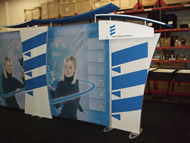Lighting and Exhibit and Electrical Supplies Galleries
Classic Exhibits Inc., a designer and manufacturer of portable, modular, and custom hybrid displays, announces the addition of Display Supply & Lighting’s (DS&L) products to Exhibit Design Search. Exhibit Design Search (EDS) is a comprehensive web-based search tool for trade show displays and accessories, and includes over 1400 displays, 2000 photos, and 50 trade show articles. Most Classic Distributors have branded versions of EDS on their websites.
The two new galleries, Lighting and Exhibit and Electrical Supplies, supplement the existing 26 display galleries by adding a complete line of halogen, LED, fluorescent, and incandescent lights to the search database, along with display needs like Velcro® brand products, multi-outlet strips, and replacement cords.
DS&L joins four other vendors as strategic partners in Exhibit Design Search. Those partners include Eco-systems Sustainable Exhibits, Optima Graphics, Brumark Flooring, and Classic Exhibits. Each partner contributes to and manages galleries that reflect their expertise and product lines. Classic Distributors benefit from a “one-stop shop” on their website and can order products directly from each strategic partner.
According to Rob Cohen, Vice President of DS&L, “DS&L is excited to support the efforts of our partners to market solutions using technology in sustainable, cost-effective tools like EDS. Classic Exhibits has built an effective portal that allows distributors and their customers to easily learn more about, and select, products that meet their needs, and we are proud to be a part of that solution.”
“We are delighted to partner with DS&L,” says Kevin Carty, VP of Sales at Classic Exhibits. “This collaboration reflects our core philosophy of “Shared Success,” in which we work with industry leaders to create best-in-class solutions for our distributors and their customers. For customers, Exhibit Design Search makes it easy to find the right products at the right price using a web-based search tool that promotes the brands that matter – our distributor’s brands. In this way, we win, our customers win, and our suppliers win.”
For questions about Classic Exhibits or Exhibit Design Search, contact Mel White, VP of Marketing and Business Development at mel@classicexhibits.com or 503.652-2100 x-210. For more information about Classic Exhibits, refer to www.classicexhibits.com or www.classicmodul.com.
**************
Based in Portland, Oregon, Classic Exhibits Inc. designs and manufacturers portable, modular, and custom-hybrid exhibit solutions. These solutions include the Perfect 10, Sacagawea, Magellan, Euro LT, and Visionary Designs. The Classic line also includes ClassicMODUL Aluminum Extrusions with over 200 profiles and hundreds of accessories for trade show, museum, architectural, and retail environments. Classic Exhibits products are represented by an extensive distributor network throughout North America and in select International markets.












